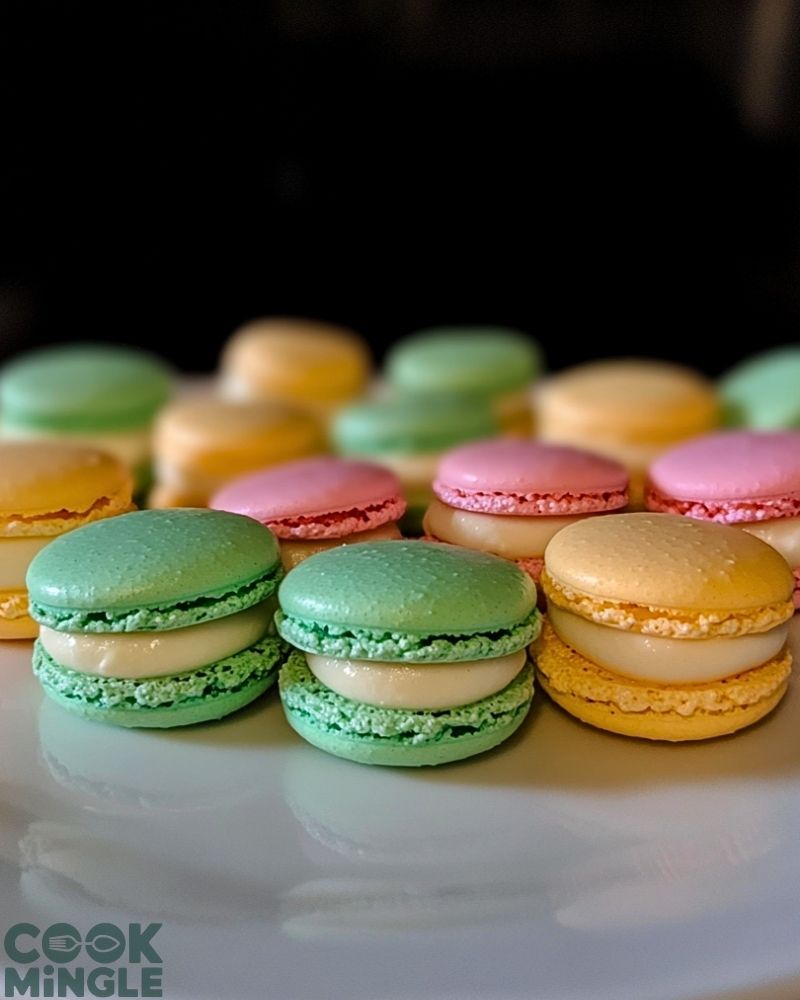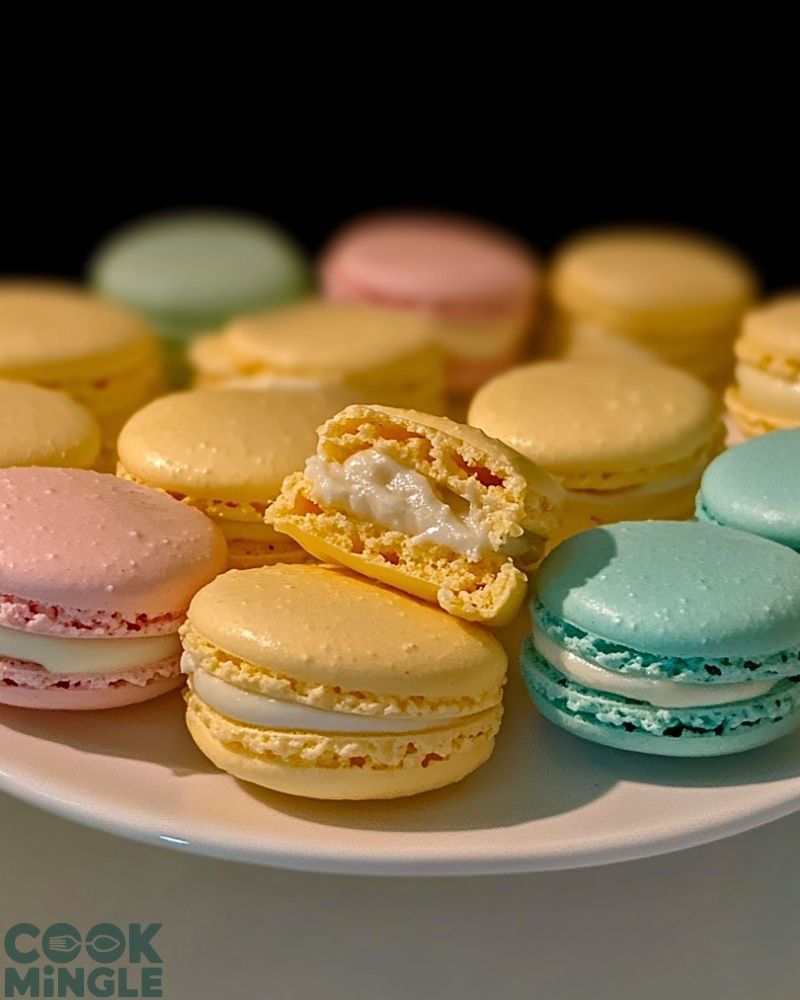Soft and chewy on the inside, crisp on the outside, and delicately sandwiched with creamy filling — these Easy Macarons for Beginners bring the elegance of a French patisserie right to your kitchen. With their pastel hues and dainty size, macarons are a charming treat for special occasions or a delightful indulgence with your afternoon tea.

Despite their refined look, making macarons at home is absolutely achievable — even for beginners. This recipe breaks down the process into manageable steps, focusing on techniques that reduce the usual margin for error. Whether you’re a baking novice or just trying macarons for the first time, you’ll find this guide approachable, clear, and rewarding.
Why You’ll Love This Easy Macaron for Beginners Recipe
- Beginner-friendly instructions that simplify a famously tricky dessert.
- Minimal tools required, yet results that look and taste professional.
- Customizable colors and fillings for any season or celebration.
- A rewarding baking challenge with impressive results.
- Naturally gluten-free and great for gifting.
Preparation Phase & Tools to Use for Easy Macaron for Beginners
Making macarons requires precision and patience, and the right tools can make a world of difference. Here’s what you’ll need and why each one matters:
- Kitchen Scale – Accuracy is everything in macaron making. A scale ensures your almond flour, powdered sugar, and egg whites are perfectly measured.
- Fine Mesh Sieve – Sifting almond flour and powdered sugar removes clumps and ensures a smooth, uniform batter.
- Electric Mixer (Hand or Stand) – Whipping egg whites to the right stiffness is crucial. A mixer saves time and provides better control.
- Silicone Spatula – Ideal for folding batter during the macaronage step without deflating it.
- Piping Bag with Round Tip – Creates even, neat circles for consistent macarons.
- Silicone Baking Mat or Parchment Paper – Prevents sticking and helps macarons bake evenly.
- Baking Sheet – A sturdy sheet supports even heat distribution.
- Oven Thermometer – Macarons are sensitive to temperature fluctuations. This ensures your oven is at the correct heat.
Preparation Tips
Before diving in, a few key tips can boost your success on the first try:
- Age your egg whites: Let them sit in the fridge for 24 hours (or at room temp for 2–3 hours). This helps achieve the right meringue consistency.
- Use gel food coloring: Liquid food coloring can alter batter consistency. Gel adds vibrant color without changing texture.
- Pre-measure everything: Have your ingredients ready to avoid rushing during critical steps.
- Wipe tools clean: Make sure all bowls and beaters are grease-free so the egg whites whip properly.
- Work in a dry, cool room: Humidity can ruin macarons. Choose a dry day or use a dehumidifier if needed.
Ingredients for Easy Macaron for Beginners
Here’s what you’ll need to make a batch of colorful, crisp-yet-chewy macarons with a luscious filling. This recipe yields approximately 20–24 complete macarons (40–48 shells).
For the Macaron Shells:
- 100g egg whites (aged, room temperature)
- 100g granulated sugar
- 100g almond flour (finely ground, blanched)
- 100g powdered sugar
- Gel food coloring (optional, various colors)
For the Filling (Simple Vanilla Buttercream):
- 113g unsalted butter (softened)
- 180g powdered sugar
- 1 tsp vanilla extract
- 1–2 tbsp heavy cream or milk (for desired consistency)
You can also substitute the filling with jam, chocolate ganache, or flavored buttercream to match different colors or occasions.

Step 1: Sift the Dry Ingredients
In a large mixing bowl, sift together the almond flour and powdered sugar. Discard any coarse bits that remain in the sieve. This ensures a smooth, lump-free batter and silky macaron shells.
Step 2: Make the French Meringue
Place the aged egg whites into a clean, grease-free bowl. Start whisking on medium speed using a stand or hand mixer. Once foamy, gradually add granulated sugar. Continue to whip until stiff, glossy peaks form. At this stage, you may add gel food coloring and beat just enough to incorporate it evenly.
Step 3: Macaronage (Folding)
Add the sifted almond flour mixture into the meringue in three additions. Gently fold with a silicone spatula using a circular-and-press motion. The batter is ready when it flows like lava and you can form a figure-8 with the batter without it breaking.
Step 4: Pipe the Shells
Transfer the batter into a piping bag fitted with a round tip. Pipe uniform circles onto a parchment-lined or silicone-mat-lined baking sheet. Tap the tray firmly against the counter a few times to release air bubbles. Use a toothpick to pop any stubborn bubbles for smooth tops.
Step 5: Rest the Shells
Let the piped macarons sit at room temperature for 30–60 minutes until a skin forms on the surface. You’ll know they’re ready when you can lightly touch them without batter sticking to your finger.
Step 6: Bake
Preheat your oven to 300°F (150°C). Bake the macarons on the center rack for 14–16 minutes. The tops should be set and the signature “feet” should have formed. Let them cool completely before removing from the tray.
Step 7: Make the Filling
While the shells cool, beat softened butter until creamy. Add powdered sugar, vanilla, and cream, then beat until smooth and fluffy. Adjust with more cream or sugar as needed for consistency.
Step 8: Assemble
Match shells of similar size. Pipe a small amount of filling onto the flat side of one shell, then sandwich with another. Gently press until the filling spreads evenly to the edge.
Step 9: Mature (Optional but Recommended)
Place assembled macarons in an airtight container and refrigerate for 24 hours. This allows the flavors to meld and gives that perfect chewy texture. Bring to room temperature before serving.
Notes
- Precision is key: Even slight changes in ratios can affect the outcome, so always use a digital scale.
- Macaronage takes practice: The right batter consistency — not too runny or stiff — is the trickiest but most crucial step.
- Color fades slightly during baking: Use slightly more gel color than you’d think if you’re aiming for bold hues.
- Customize flavors: Add different extracts (like almond, lemon, or rose) to the buttercream or shells.
- Double trays for even baking: Placing a second tray beneath your baking sheet can prevent overbrowning on the bottom.
- Shells store well: You can freeze the shells (unfilled) for up to 2 months.
Watch Out for These Mistakes While Cooking
- Skipping the sifting step: Leads to grainy, lumpy shells that don’t rise properly.
- Over or under-whipping the meringue: Soft peaks won’t hold structure; over-beaten eggs become dry and clumpy.
- Incorrect macaronage: Over-mixing results in runny batter and flat shells; under-mixing leaves them cracked or with peaks.
- Humidity: Trying to bake on a damp day without proper air conditioning or a dehumidifier may ruin the shells’ texture.
- Not letting them rest: If you skip this, they won’t develop feet and might crack.
- Uneven oven heat: Hot spots can cause uneven rise and browning — use an oven thermometer to stay accurate.
- Opening the oven too early: This can cause shells to collapse. Avoid opening before at least 12 minutes of bake time.
- Piping inconsistently: Results in uneven shells that are hard to match when assembling.
What to Serve With Easy Macaron for Beginners?
Pair your delicate macarons with equally elegant or complementary drinks and treats to elevate the entire experience. Whether you’re planning a tea party, a dessert board, or a festive spread, these options work beautifully:
8 Recommendations
- Earl Grey or Lavender Tea
The floral notes of these teas beautifully complement the subtle sweetness of macarons. - Champagne or Sparkling Wine
Perfect for special occasions — the crisp bubbles balance the richness of buttercream fillings. - Fruit Platters
Fresh berries, grapes, or sliced kiwi add brightness and color contrast on the serving tray. - Coffee or Espresso
A bold, bitter espresso shot cuts through the sweetness and intensifies flavor notes. - Mini Cheesecakes
These creamy bites pair well with macarons on a dessert table. - Chocolate-Dipped Strawberries
Adds indulgence and a romantic flair — especially for themed events like Valentine’s or anniversaries. - Lemon Bars or Tartlets
The tanginess provides a nice counterpoint to the sweetness of the macarons. - Iced Matcha Latte
The earthy taste of matcha works wonderfully with fruity or vanilla-filled macarons.
Storage Instructions
Proper storage helps maintain the signature chewy texture and delicate crunch of your macarons:
- Refrigeration (Assembled): Store in an airtight container in the refrigerator for up to 5 days. Always allow them to come to room temperature for 20–30 minutes before serving.
- Refrigeration (Shells Only): If you haven’t filled them yet, you can store shells separately for 7 days in an airtight container.
- Freezing:
- Shells: Can be frozen for up to 2 months in layers between parchment paper inside a zip-lock or airtight container.
- Assembled Macarons: Freeze individually wrapped or separated by parchment. Thaw overnight in the refrigerator, then bring to room temperature.
Avoid moisture and temperature swings, which can make the shells soggy or sticky.
Estimated Nutrition (Per Macaron – standard size with buttercream filling)
- Calories: 100–120 kcal
- Carbohydrates: 14g
- Protein: 2g
- Fat: 5g
- Saturated Fat: 3g
- Cholesterol: 10mg
- Sodium: 5mg
- Sugar: 12g
- Fiber: 0.5g
Note: These values are approximate and vary depending on size, coloring, and filling variations.
Frequently Asked Questions
1. Why did my macarons crack on top?
Cracks usually mean the shells didn’t rest long enough, or there was too much air in the batter. Ensure you tap the tray and let the skin form properly before baking.
2. How do I know when the meringue is ready?
Your meringue should have stiff, glossy peaks. When you lift the whisk, the peaks should stand upright without drooping.
3. Can I make macarons without almond flour?
Almond flour is traditional, but you can try sunflower seed flour as a nut-free alternative. The texture may vary slightly.
4. Can I use liquid food coloring instead of gel?
It’s not recommended. Liquid coloring can alter the batter’s moisture and throw off consistency. Gel or powder colorants work best.
5. How do I prevent hollow shells?
This usually results from overmixing or underbaking. Make sure your oven is at the right temperature and avoid over-deflating the batter.
6. Is it okay to bake two trays at once?
Not ideal. Macarons bake best with even airflow and consistent heat, so stick to one tray at a time for uniform results.
7. Can I fill the macarons with jam or ganache instead of buttercream?
Absolutely! Ganache, fruit preserves, lemon curd, or cream cheese frostings all make delicious alternatives.
8. Why do I need to age egg whites?
Aging reduces moisture and helps them whip to a more stable meringue. It improves consistency and reduces cracking or hollowness.
Conclusion
Macarons may seem intimidating, but with the right technique and a bit of patience, even a novice baker can master these elegant treats. This Easy Macaron for Beginners guide simplifies each step without compromising on the stunning results. Crisp shells, chewy centers, and customizable fillings make them a showstopper for any occasion. Give it a try — your homemade batch might just rival the ones from your favorite patisserie!

Easy Macaron for Beginners
- Total Time: 55 minutes
- Yield: 20-24 macarons
Description
Elegant, colorful, and melt-in-your-mouth delicious, these Easy Macarons for Beginners are a delightful way to try your hand at a classic French dessert. With detailed steps and simple ingredients, this recipe makes it easy for anyone to achieve patisserie-worthy results right at home.
Ingredients
For the Macaron Shells:
- 100g egg whites (aged, room temperature)
- 100g granulated sugar
- 100g almond flour (finely ground, blanched)
- 100g powdered sugar
- Gel food coloring (optional)
For Vanilla Buttercream Filling:
- 113g unsalted butter (softened)
- 180g powdered sugar
- 1 tsp vanilla extract
- 1–2 tbsp heavy cream or milk
Instructions
- Sift together almond flour and powdered sugar into a bowl. Discard any coarse bits.
- In a clean bowl, beat egg whites until foamy, then gradually add granulated sugar. Whip until stiff, glossy peaks form. Add food coloring if desired.
- Fold the sifted dry ingredients into the meringue in three additions. Mix gently until the batter flows like lava.
- Transfer batter to a piping bag with a round tip and pipe small circles onto a lined baking sheet.
- Tap the baking sheet to release air bubbles. Use a toothpick to pop any visible bubbles.
- Let the shells rest for 30–60 minutes until a skin forms.
- Preheat oven to 300°F (150°C). Bake for 14–16 minutes. Let cool completely.
- Beat softened butter, powdered sugar, vanilla, and cream until smooth to make the filling.
- Pipe filling onto half of the shells and top with matching halves.
- Optionally, refrigerate for 24 hours to mature before serving.
- Prep Time: 40 minutes
- Cook Time: 15 minutes

